Financial Management Assignment: Capital Budgeting and Working Capital
VerifiedAdded on 2020/04/15
|10
|2033
|52
Homework Assignment
AI Summary
This assignment delves into core financial management principles, analyzing two investment projects (A and B) using Net Present Value (NPV) and payback period methods. It calculates the NPV for each project, considering initial cash outflows, cash inflows, and a 12% discount rate, determining their profitability. The assignment then explores the concept of mutually exclusive projects, recommending the selection of Project B based on resource availability. Furthermore, it explains the payback period, its calculation, advantages, and disadvantages, highlighting its limitations in considering the time value of money and overall project profitability. The assignment also defines working capital, differentiating between gross and net working capital, and discusses its importance for day-to-day business operations. It examines the working capital cycle, its components, and various financing sources. Finally, it provides recommendations to reduce the working capital cycle length, such as analyzing costs, choosing vendors with discounts, managing inventory, improving manufacturing processes, and reducing credit periods. The assignment concludes with a comprehensive list of references supporting the analysis.
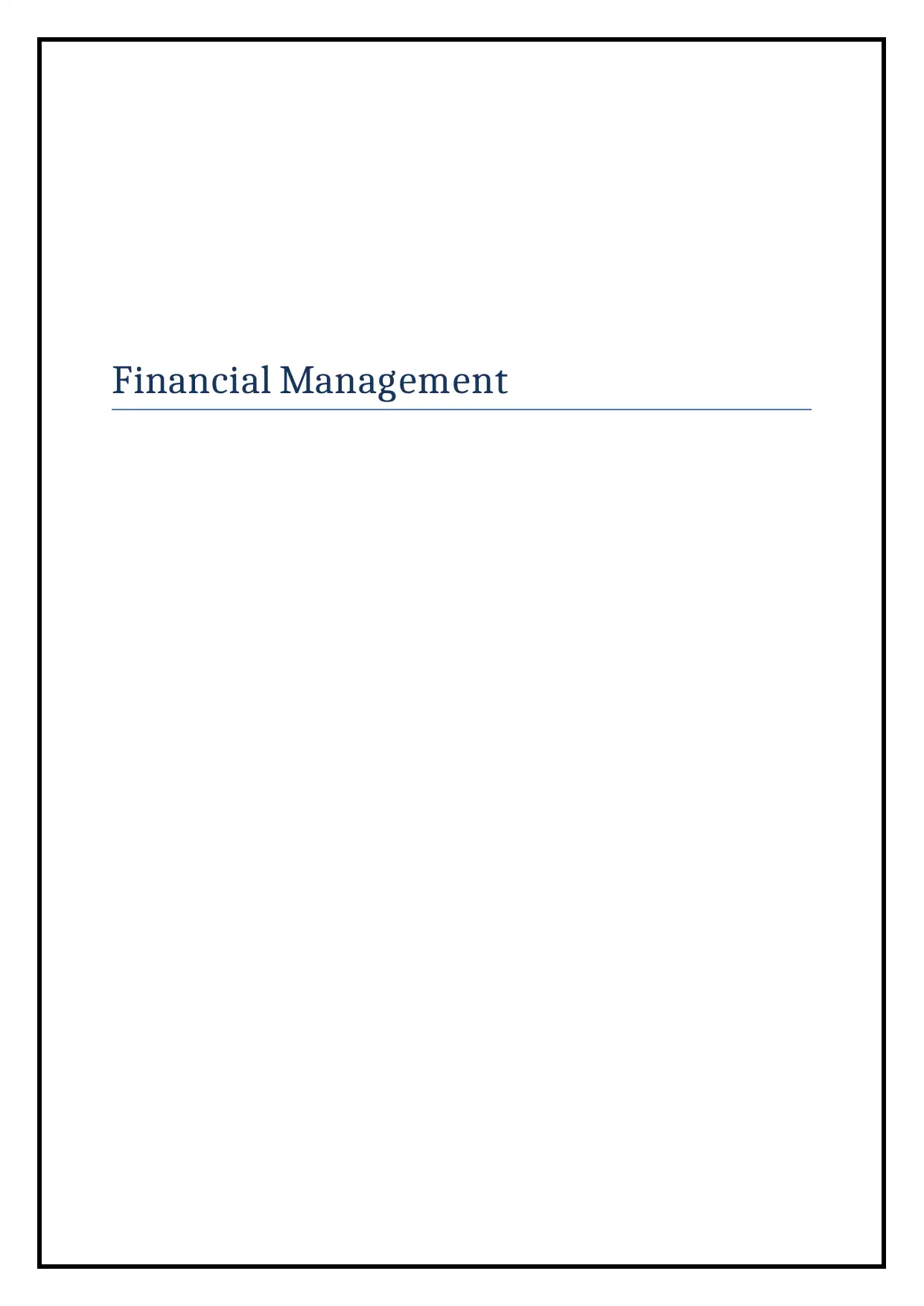
Financial Management
Paraphrase This Document
Need a fresh take? Get an instant paraphrase of this document with our AI Paraphraser

Answer 1.
a. Net Present Value is the overall difference that is been evaluated among the present value
evaluated out of cash inflow and the present value that is been evaluated out of cash outflow.
This method is used in capital appraisal decisions. The NPV of both the project is shown in
the table given below:
NPV of the Project investment A
Initial Cash Outflow = $100,000
Time
length
Cash
Inflows
PV Factor
@ 12%
Cash inflows at
present value
level
1 30,000 0.893 26790
2 35,000 0.797 27895
3 40,000 0.712 28480
4 45,000 0.636 28620
5 55,000 0.567 31185
Total 2,05,000 142970
The formulae of NPV (Net present value) = PV of Cash Inflows - PV of Cash
Outflow
a. Net Present Value is the overall difference that is been evaluated among the present value
evaluated out of cash inflow and the present value that is been evaluated out of cash outflow.
This method is used in capital appraisal decisions. The NPV of both the project is shown in
the table given below:
NPV of the Project investment A
Initial Cash Outflow = $100,000
Time
length
Cash
Inflows
PV Factor
@ 12%
Cash inflows at
present value
level
1 30,000 0.893 26790
2 35,000 0.797 27895
3 40,000 0.712 28480
4 45,000 0.636 28620
5 55,000 0.567 31185
Total 2,05,000 142970
The formulae of NPV (Net present value) = PV of Cash Inflows - PV of Cash
Outflow
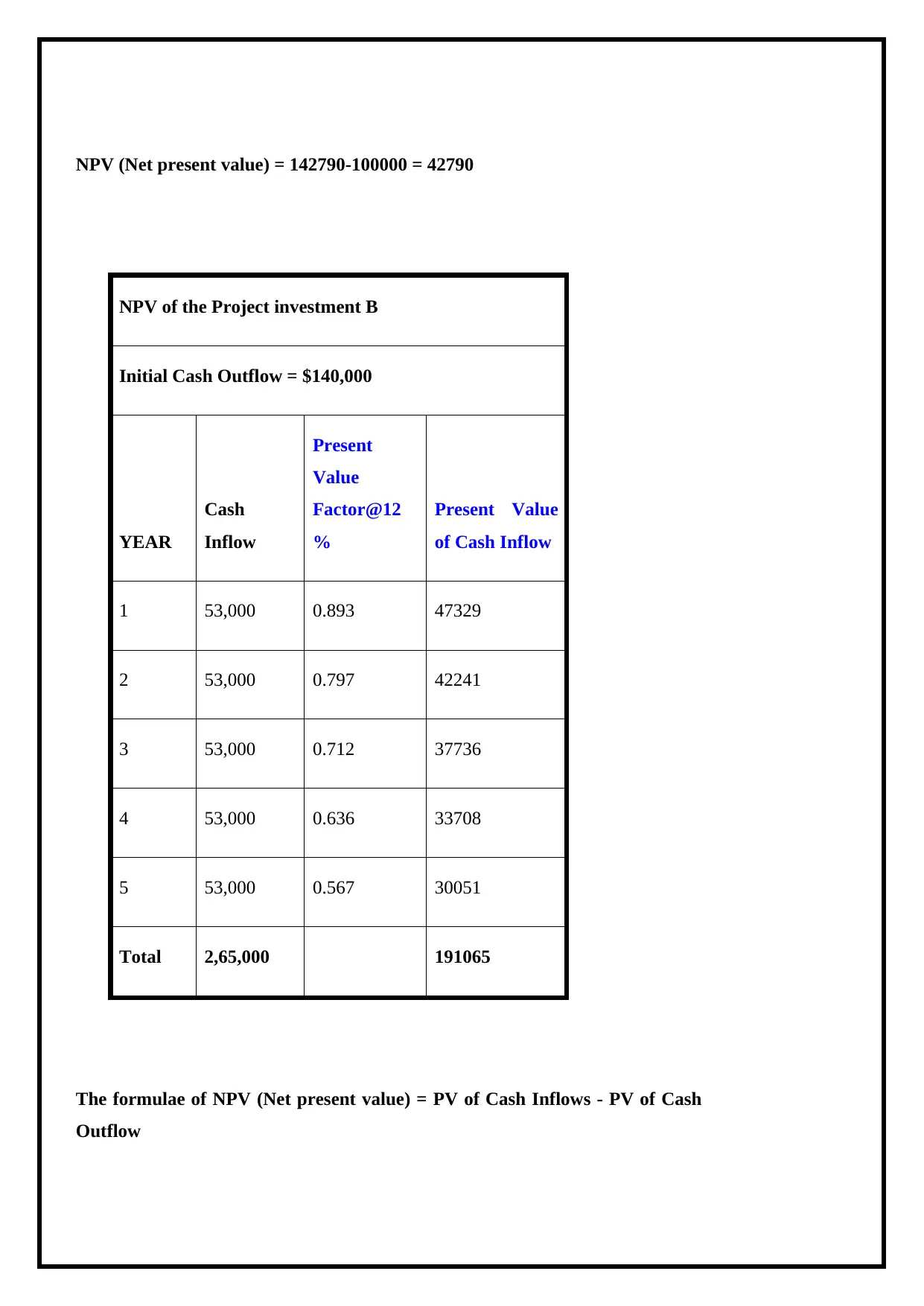
NPV (Net present value) = 142790-100000 = 42790
NPV of the Project investment B
Initial Cash Outflow = $140,000
YEAR
Cash
Inflow
Present
Value
Factor@12
%
Present Value
of Cash Inflow
1 53,000 0.893 47329
2 53,000 0.797 42241
3 53,000 0.712 37736
4 53,000 0.636 33708
5 53,000 0.567 30051
Total 2,65,000 191065
The formulae of NPV (Net present value) = PV of Cash Inflows - PV of Cash
Outflow
NPV of the Project investment B
Initial Cash Outflow = $140,000
YEAR
Cash
Inflow
Present
Value
Factor@12
%
Present Value
of Cash Inflow
1 53,000 0.893 47329
2 53,000 0.797 42241
3 53,000 0.712 37736
4 53,000 0.636 33708
5 53,000 0.567 30051
Total 2,65,000 191065
The formulae of NPV (Net present value) = PV of Cash Inflows - PV of Cash
Outflow
⊘ This is a preview!⊘
Do you want full access?
Subscribe today to unlock all pages.

Trusted by 1+ million students worldwide
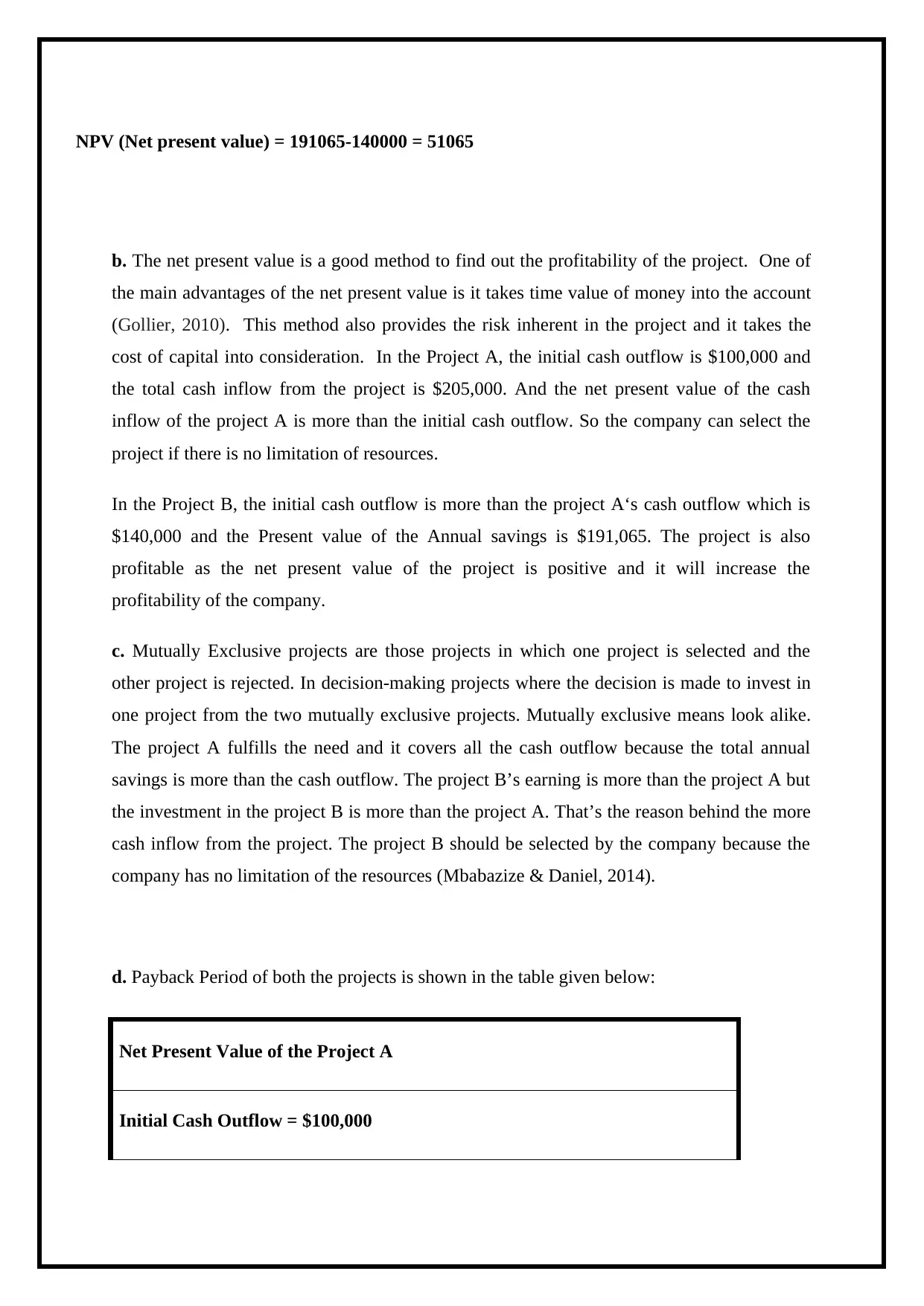
NPV (Net present value) = 191065-140000 = 51065
b. The net present value is a good method to find out the profitability of the project. One of
the main advantages of the net present value is it takes time value of money into the account
(Gollier, 2010). This method also provides the risk inherent in the project and it takes the
cost of capital into consideration. In the Project A, the initial cash outflow is $100,000 and
the total cash inflow from the project is $205,000. And the net present value of the cash
inflow of the project A is more than the initial cash outflow. So the company can select the
project if there is no limitation of resources.
In the Project B, the initial cash outflow is more than the project A‘s cash outflow which is
$140,000 and the Present value of the Annual savings is $191,065. The project is also
profitable as the net present value of the project is positive and it will increase the
profitability of the company.
c. Mutually Exclusive projects are those projects in which one project is selected and the
other project is rejected. In decision-making projects where the decision is made to invest in
one project from the two mutually exclusive projects. Mutually exclusive means look alike.
The project A fulfills the need and it covers all the cash outflow because the total annual
savings is more than the cash outflow. The project B’s earning is more than the project A but
the investment in the project B is more than the project A. That’s the reason behind the more
cash inflow from the project. The project B should be selected by the company because the
company has no limitation of the resources (Mbabazize & Daniel, 2014).
d. Payback Period of both the projects is shown in the table given below:
Net Present Value of the Project A
Initial Cash Outflow = $100,000
b. The net present value is a good method to find out the profitability of the project. One of
the main advantages of the net present value is it takes time value of money into the account
(Gollier, 2010). This method also provides the risk inherent in the project and it takes the
cost of capital into consideration. In the Project A, the initial cash outflow is $100,000 and
the total cash inflow from the project is $205,000. And the net present value of the cash
inflow of the project A is more than the initial cash outflow. So the company can select the
project if there is no limitation of resources.
In the Project B, the initial cash outflow is more than the project A‘s cash outflow which is
$140,000 and the Present value of the Annual savings is $191,065. The project is also
profitable as the net present value of the project is positive and it will increase the
profitability of the company.
c. Mutually Exclusive projects are those projects in which one project is selected and the
other project is rejected. In decision-making projects where the decision is made to invest in
one project from the two mutually exclusive projects. Mutually exclusive means look alike.
The project A fulfills the need and it covers all the cash outflow because the total annual
savings is more than the cash outflow. The project B’s earning is more than the project A but
the investment in the project B is more than the project A. That’s the reason behind the more
cash inflow from the project. The project B should be selected by the company because the
company has no limitation of the resources (Mbabazize & Daniel, 2014).
d. Payback Period of both the projects is shown in the table given below:
Net Present Value of the Project A
Initial Cash Outflow = $100,000
Paraphrase This Document
Need a fresh take? Get an instant paraphrase of this document with our AI Paraphraser
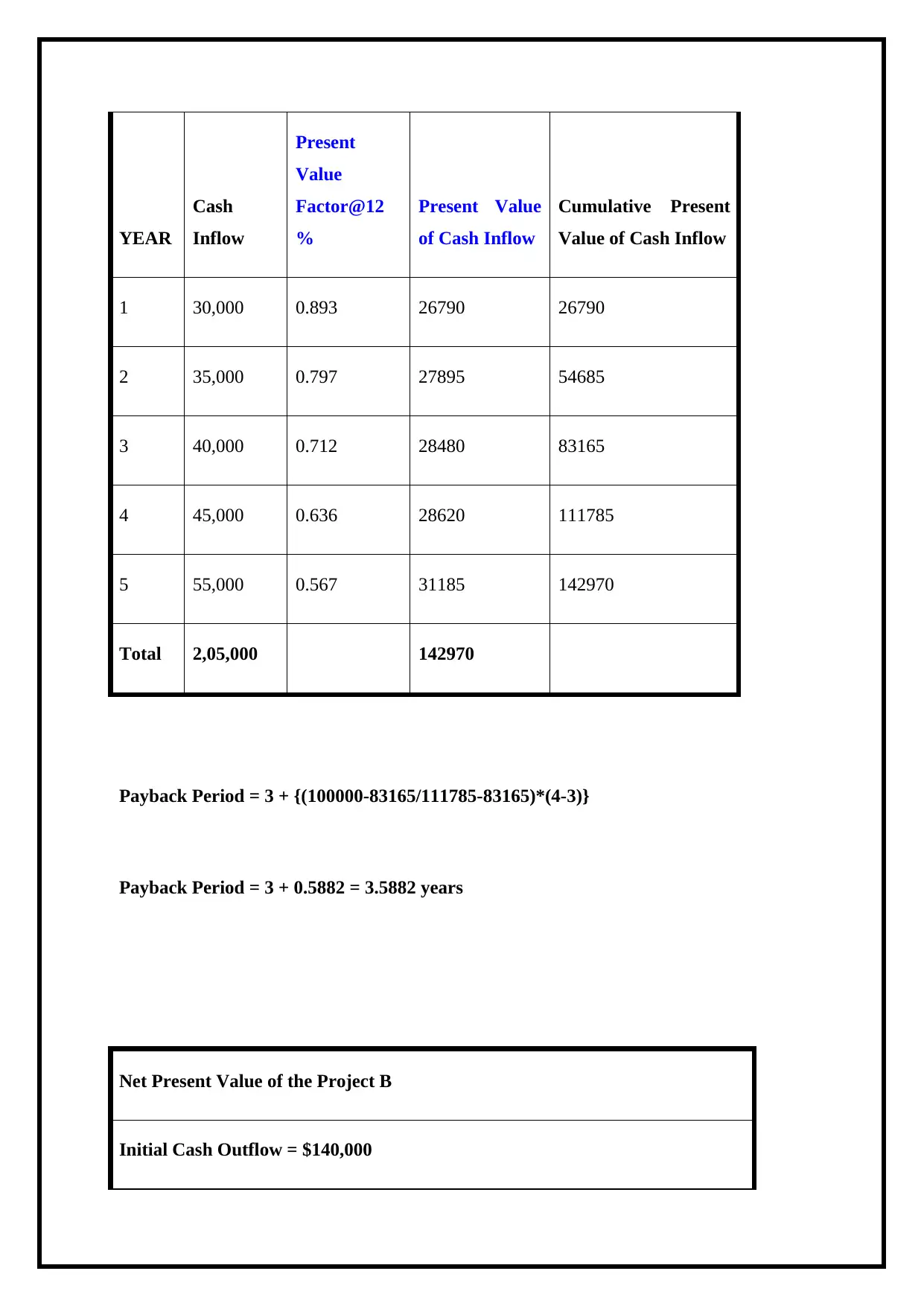
YEAR
Cash
Inflow
Present
Value
Factor@12
%
Present Value
of Cash Inflow
Cumulative Present
Value of Cash Inflow
1 30,000 0.893 26790 26790
2 35,000 0.797 27895 54685
3 40,000 0.712 28480 83165
4 45,000 0.636 28620 111785
5 55,000 0.567 31185 142970
Total 2,05,000 142970
Payback Period = 3 + {(100000-83165/111785-83165)*(4-3)}
Payback Period = 3 + 0.5882 = 3.5882 years
Net Present Value of the Project B
Initial Cash Outflow = $140,000
Cash
Inflow
Present
Value
Factor@12
%
Present Value
of Cash Inflow
Cumulative Present
Value of Cash Inflow
1 30,000 0.893 26790 26790
2 35,000 0.797 27895 54685
3 40,000 0.712 28480 83165
4 45,000 0.636 28620 111785
5 55,000 0.567 31185 142970
Total 2,05,000 142970
Payback Period = 3 + {(100000-83165/111785-83165)*(4-3)}
Payback Period = 3 + 0.5882 = 3.5882 years
Net Present Value of the Project B
Initial Cash Outflow = $140,000
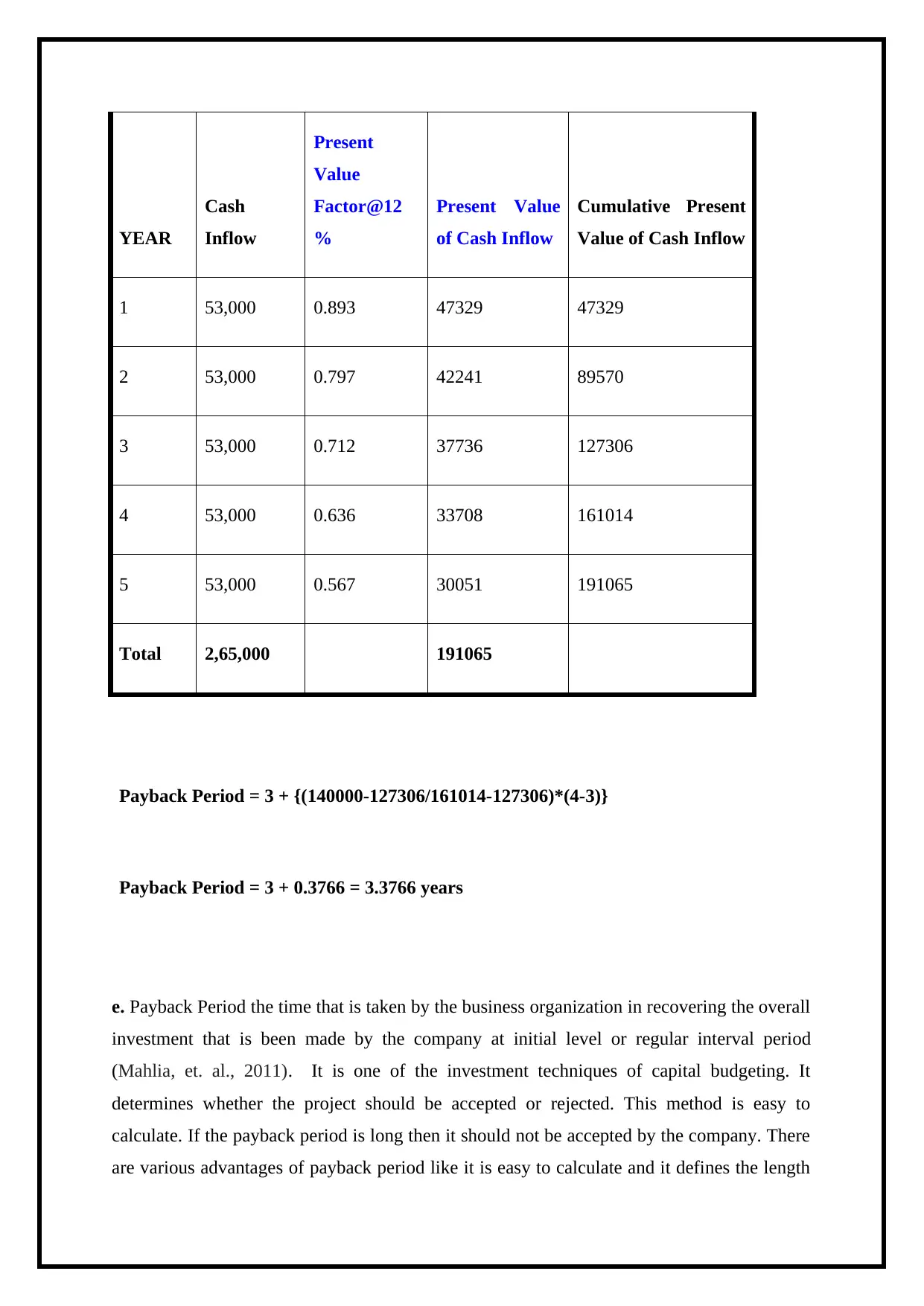
YEAR
Cash
Inflow
Present
Value
Factor@12
%
Present Value
of Cash Inflow
Cumulative Present
Value of Cash Inflow
1 53,000 0.893 47329 47329
2 53,000 0.797 42241 89570
3 53,000 0.712 37736 127306
4 53,000 0.636 33708 161014
5 53,000 0.567 30051 191065
Total 2,65,000 191065
Payback Period = 3 + {(140000-127306/161014-127306)*(4-3)}
Payback Period = 3 + 0.3766 = 3.3766 years
e. Payback Period the time that is taken by the business organization in recovering the overall
investment that is been made by the company at initial level or regular interval period
(Mahlia, et. al., 2011). It is one of the investment techniques of capital budgeting. It
determines whether the project should be accepted or rejected. This method is easy to
calculate. If the payback period is long then it should not be accepted by the company. There
are various advantages of payback period like it is easy to calculate and it defines the length
Cash
Inflow
Present
Value
Factor@12
%
Present Value
of Cash Inflow
Cumulative Present
Value of Cash Inflow
1 53,000 0.893 47329 47329
2 53,000 0.797 42241 89570
3 53,000 0.712 37736 127306
4 53,000 0.636 33708 161014
5 53,000 0.567 30051 191065
Total 2,65,000 191065
Payback Period = 3 + {(140000-127306/161014-127306)*(4-3)}
Payback Period = 3 + 0.3766 = 3.3766 years
e. Payback Period the time that is taken by the business organization in recovering the overall
investment that is been made by the company at initial level or regular interval period
(Mahlia, et. al., 2011). It is one of the investment techniques of capital budgeting. It
determines whether the project should be accepted or rejected. This method is easy to
calculate. If the payback period is long then it should not be accepted by the company. There
are various advantages of payback period like it is easy to calculate and it defines the length
⊘ This is a preview!⊘
Do you want full access?
Subscribe today to unlock all pages.

Trusted by 1+ million students worldwide
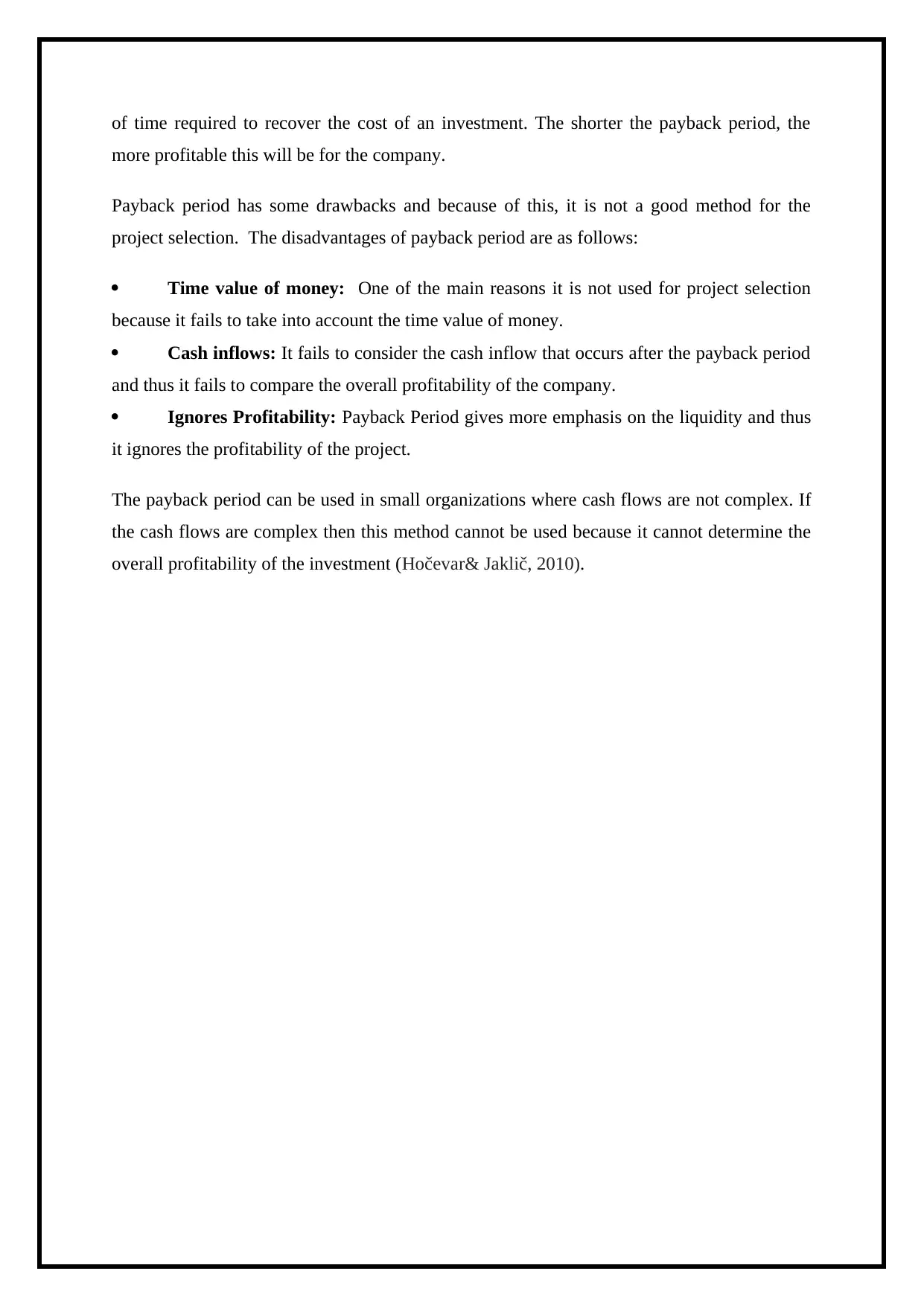
of time required to recover the cost of an investment. The shorter the payback period, the
more profitable this will be for the company.
Payback period has some drawbacks and because of this, it is not a good method for the
project selection. The disadvantages of payback period are as follows:
Time value of money: One of the main reasons it is not used for project selection
because it fails to take into account the time value of money.
Cash inflows: It fails to consider the cash inflow that occurs after the payback period
and thus it fails to compare the overall profitability of the company.
Ignores Profitability: Payback Period gives more emphasis on the liquidity and thus
it ignores the profitability of the project.
The payback period can be used in small organizations where cash flows are not complex. If
the cash flows are complex then this method cannot be used because it cannot determine the
overall profitability of the investment (Hočevar& Jaklič, 2010).
more profitable this will be for the company.
Payback period has some drawbacks and because of this, it is not a good method for the
project selection. The disadvantages of payback period are as follows:
Time value of money: One of the main reasons it is not used for project selection
because it fails to take into account the time value of money.
Cash inflows: It fails to consider the cash inflow that occurs after the payback period
and thus it fails to compare the overall profitability of the company.
Ignores Profitability: Payback Period gives more emphasis on the liquidity and thus
it ignores the profitability of the project.
The payback period can be used in small organizations where cash flows are not complex. If
the cash flows are complex then this method cannot be used because it cannot determine the
overall profitability of the investment (Hočevar& Jaklič, 2010).
Paraphrase This Document
Need a fresh take? Get an instant paraphrase of this document with our AI Paraphraser
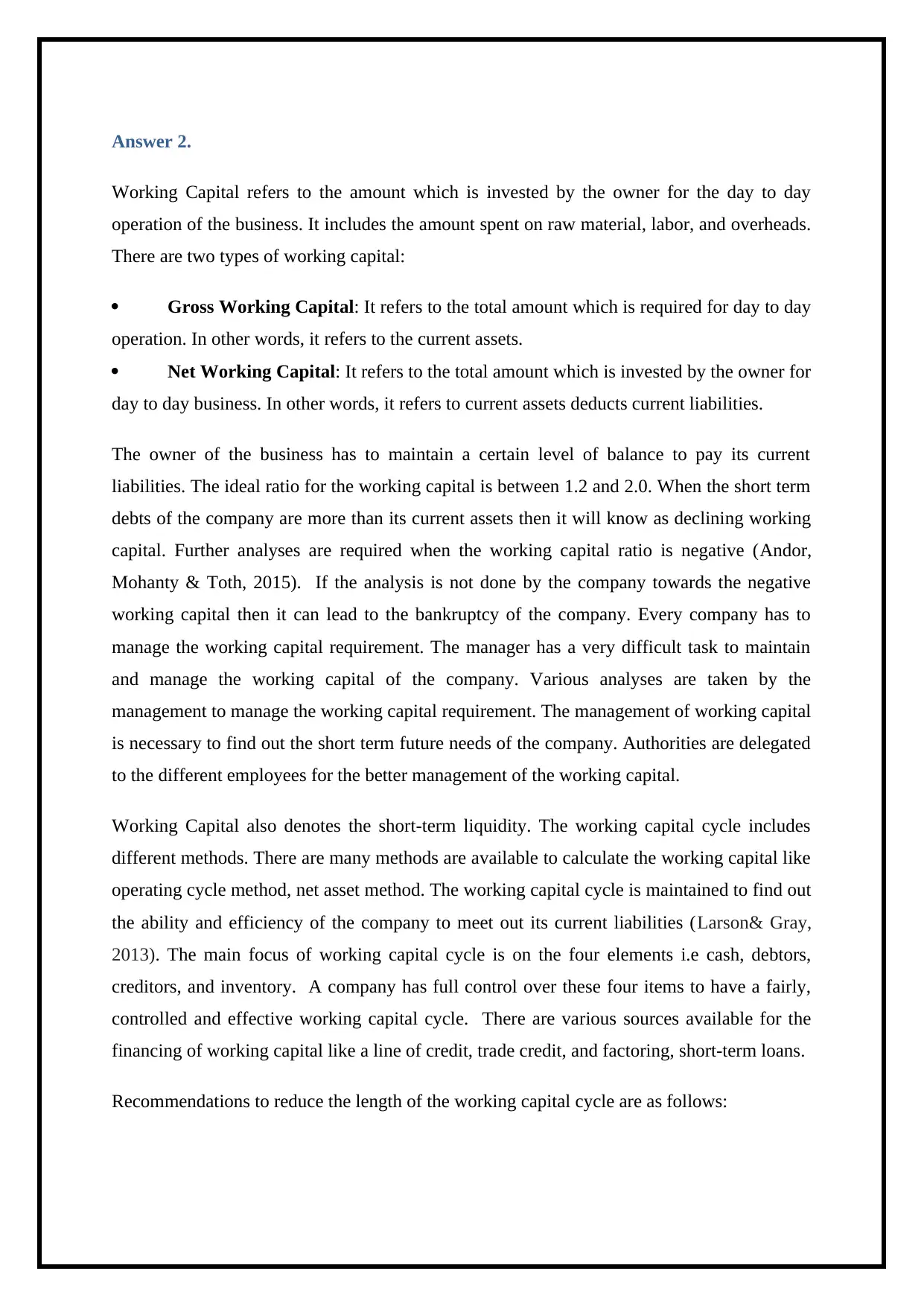
Answer 2.
Working Capital refers to the amount which is invested by the owner for the day to day
operation of the business. It includes the amount spent on raw material, labor, and overheads.
There are two types of working capital:
Gross Working Capital: It refers to the total amount which is required for day to day
operation. In other words, it refers to the current assets.
Net Working Capital: It refers to the total amount which is invested by the owner for
day to day business. In other words, it refers to current assets deducts current liabilities.
The owner of the business has to maintain a certain level of balance to pay its current
liabilities. The ideal ratio for the working capital is between 1.2 and 2.0. When the short term
debts of the company are more than its current assets then it will know as declining working
capital. Further analyses are required when the working capital ratio is negative (Andor,
Mohanty & Toth, 2015). If the analysis is not done by the company towards the negative
working capital then it can lead to the bankruptcy of the company. Every company has to
manage the working capital requirement. The manager has a very difficult task to maintain
and manage the working capital of the company. Various analyses are taken by the
management to manage the working capital requirement. The management of working capital
is necessary to find out the short term future needs of the company. Authorities are delegated
to the different employees for the better management of the working capital.
Working Capital also denotes the short-term liquidity. The working capital cycle includes
different methods. There are many methods are available to calculate the working capital like
operating cycle method, net asset method. The working capital cycle is maintained to find out
the ability and efficiency of the company to meet out its current liabilities (Larson& Gray,
2013). The main focus of working capital cycle is on the four elements i.e cash, debtors,
creditors, and inventory. A company has full control over these four items to have a fairly,
controlled and effective working capital cycle. There are various sources available for the
financing of working capital like a line of credit, trade credit, and factoring, short-term loans.
Recommendations to reduce the length of the working capital cycle are as follows:
Working Capital refers to the amount which is invested by the owner for the day to day
operation of the business. It includes the amount spent on raw material, labor, and overheads.
There are two types of working capital:
Gross Working Capital: It refers to the total amount which is required for day to day
operation. In other words, it refers to the current assets.
Net Working Capital: It refers to the total amount which is invested by the owner for
day to day business. In other words, it refers to current assets deducts current liabilities.
The owner of the business has to maintain a certain level of balance to pay its current
liabilities. The ideal ratio for the working capital is between 1.2 and 2.0. When the short term
debts of the company are more than its current assets then it will know as declining working
capital. Further analyses are required when the working capital ratio is negative (Andor,
Mohanty & Toth, 2015). If the analysis is not done by the company towards the negative
working capital then it can lead to the bankruptcy of the company. Every company has to
manage the working capital requirement. The manager has a very difficult task to maintain
and manage the working capital of the company. Various analyses are taken by the
management to manage the working capital requirement. The management of working capital
is necessary to find out the short term future needs of the company. Authorities are delegated
to the different employees for the better management of the working capital.
Working Capital also denotes the short-term liquidity. The working capital cycle includes
different methods. There are many methods are available to calculate the working capital like
operating cycle method, net asset method. The working capital cycle is maintained to find out
the ability and efficiency of the company to meet out its current liabilities (Larson& Gray,
2013). The main focus of working capital cycle is on the four elements i.e cash, debtors,
creditors, and inventory. A company has full control over these four items to have a fairly,
controlled and effective working capital cycle. There are various sources available for the
financing of working capital like a line of credit, trade credit, and factoring, short-term loans.
Recommendations to reduce the length of the working capital cycle are as follows:
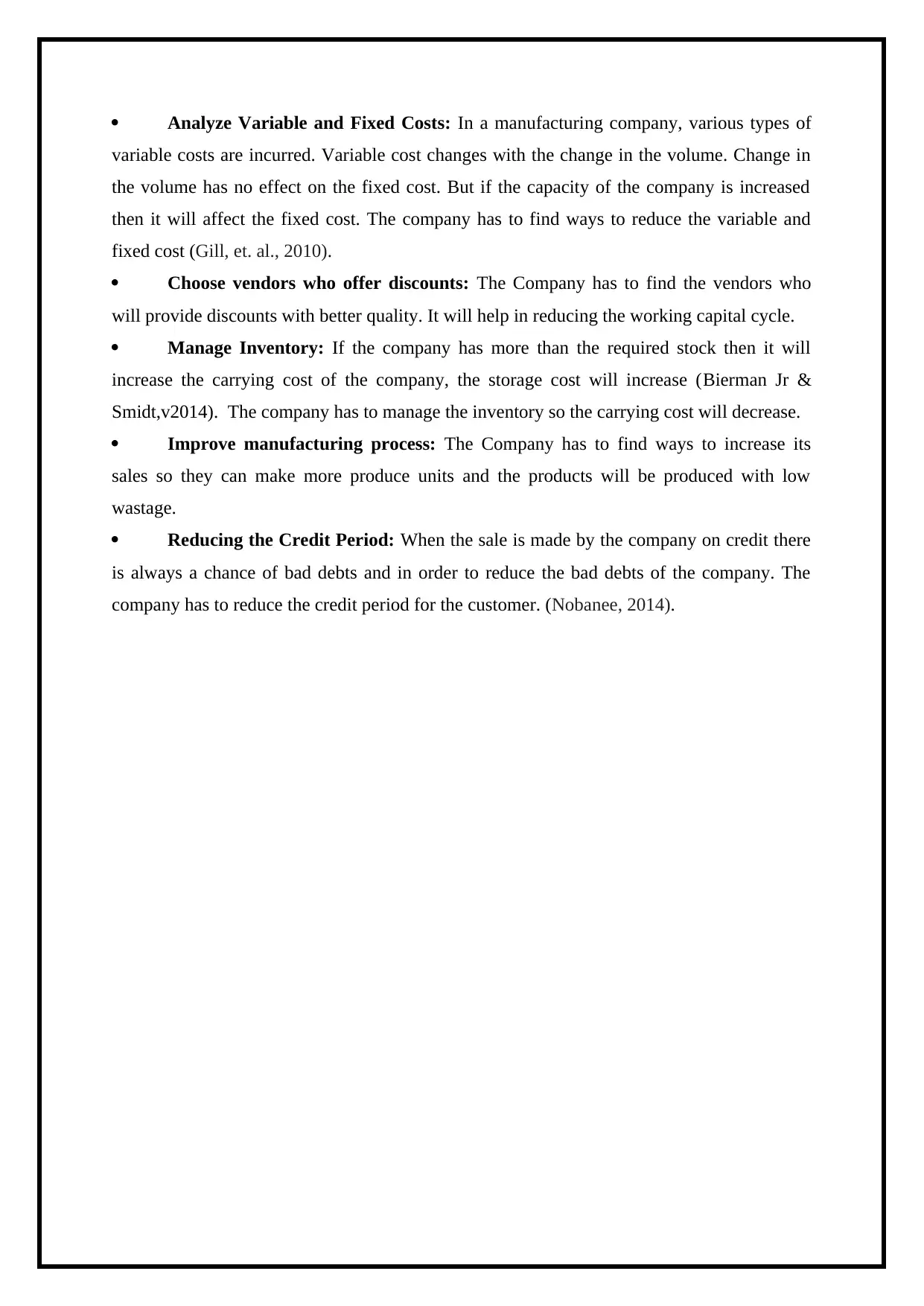
Analyze Variable and Fixed Costs: In a manufacturing company, various types of
variable costs are incurred. Variable cost changes with the change in the volume. Change in
the volume has no effect on the fixed cost. But if the capacity of the company is increased
then it will affect the fixed cost. The company has to find ways to reduce the variable and
fixed cost (Gill, et. al., 2010).
Choose vendors who offer discounts: The Company has to find the vendors who
will provide discounts with better quality. It will help in reducing the working capital cycle.
Manage Inventory: If the company has more than the required stock then it will
increase the carrying cost of the company, the storage cost will increase (Bierman Jr &
Smidt,v2014). The company has to manage the inventory so the carrying cost will decrease.
Improve manufacturing process: The Company has to find ways to increase its
sales so they can make more produce units and the products will be produced with low
wastage.
Reducing the Credit Period: When the sale is made by the company on credit there
is always a chance of bad debts and in order to reduce the bad debts of the company. The
company has to reduce the credit period for the customer. (Nobanee, 2014).
variable costs are incurred. Variable cost changes with the change in the volume. Change in
the volume has no effect on the fixed cost. But if the capacity of the company is increased
then it will affect the fixed cost. The company has to find ways to reduce the variable and
fixed cost (Gill, et. al., 2010).
Choose vendors who offer discounts: The Company has to find the vendors who
will provide discounts with better quality. It will help in reducing the working capital cycle.
Manage Inventory: If the company has more than the required stock then it will
increase the carrying cost of the company, the storage cost will increase (Bierman Jr &
Smidt,v2014). The company has to manage the inventory so the carrying cost will decrease.
Improve manufacturing process: The Company has to find ways to increase its
sales so they can make more produce units and the products will be produced with low
wastage.
Reducing the Credit Period: When the sale is made by the company on credit there
is always a chance of bad debts and in order to reduce the bad debts of the company. The
company has to reduce the credit period for the customer. (Nobanee, 2014).
⊘ This is a preview!⊘
Do you want full access?
Subscribe today to unlock all pages.

Trusted by 1+ million students worldwide
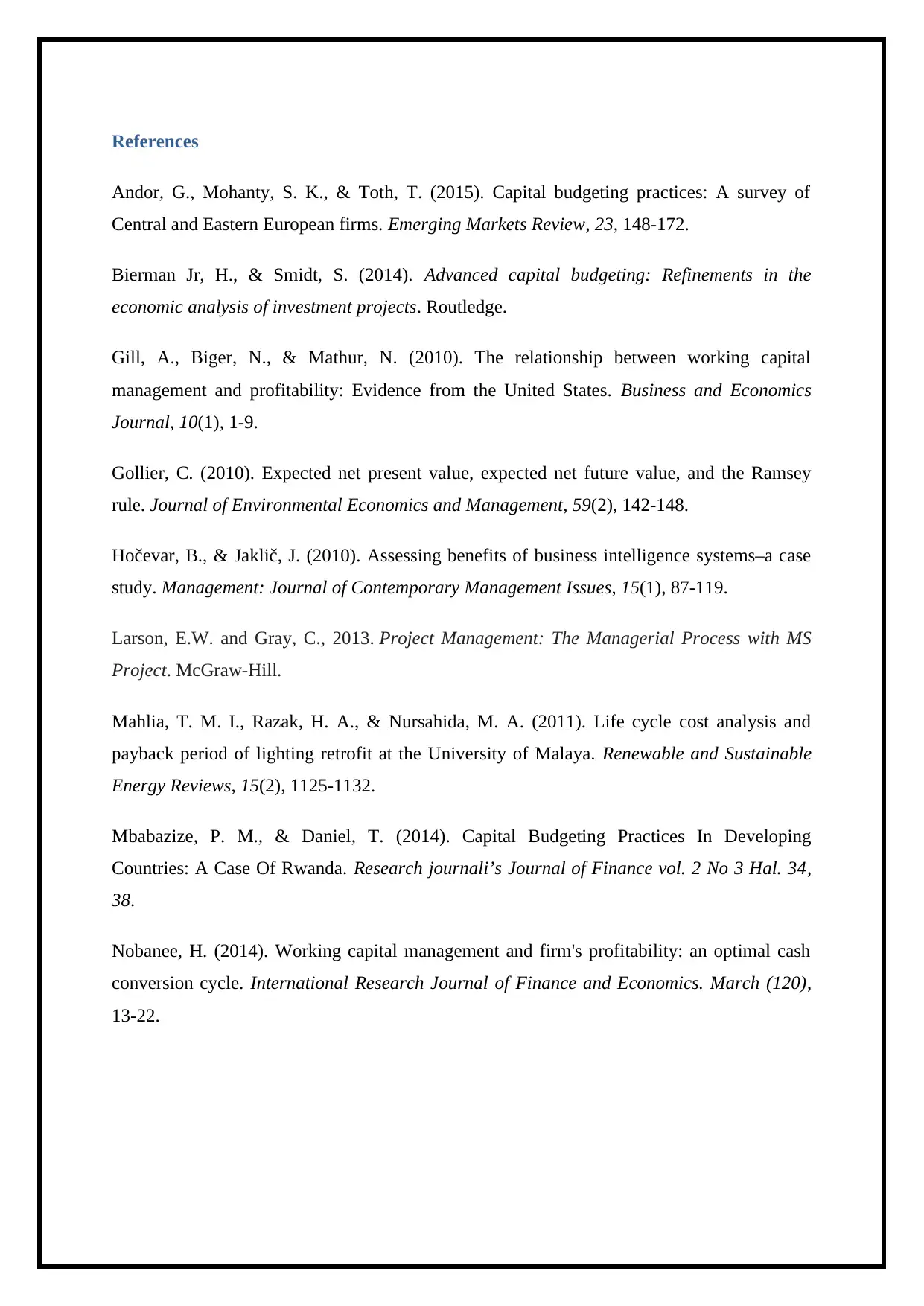
References
Andor, G., Mohanty, S. K., & Toth, T. (2015). Capital budgeting practices: A survey of
Central and Eastern European firms. Emerging Markets Review, 23, 148-172.
Bierman Jr, H., & Smidt, S. (2014). Advanced capital budgeting: Refinements in the
economic analysis of investment projects. Routledge.
Gill, A., Biger, N., & Mathur, N. (2010). The relationship between working capital
management and profitability: Evidence from the United States. Business and Economics
Journal, 10(1), 1-9.
Gollier, C. (2010). Expected net present value, expected net future value, and the Ramsey
rule. Journal of Environmental Economics and Management, 59(2), 142-148.
Hočevar, B., & Jaklič, J. (2010). Assessing benefits of business intelligence systems–a case
study. Management: Journal of Contemporary Management Issues, 15(1), 87-119.
Larson, E.W. and Gray, C., 2013. Project Management: The Managerial Process with MS
Project. McGraw-Hill.
Mahlia, T. M. I., Razak, H. A., & Nursahida, M. A. (2011). Life cycle cost analysis and
payback period of lighting retrofit at the University of Malaya. Renewable and Sustainable
Energy Reviews, 15(2), 1125-1132.
Mbabazize, P. M., & Daniel, T. (2014). Capital Budgeting Practices In Developing
Countries: A Case Of Rwanda. Research journali’s Journal of Finance vol. 2 No 3 Hal. 34,
38.
Nobanee, H. (2014). Working capital management and firm's profitability: an optimal cash
conversion cycle. International Research Journal of Finance and Economics. March (120),
13-22.
Andor, G., Mohanty, S. K., & Toth, T. (2015). Capital budgeting practices: A survey of
Central and Eastern European firms. Emerging Markets Review, 23, 148-172.
Bierman Jr, H., & Smidt, S. (2014). Advanced capital budgeting: Refinements in the
economic analysis of investment projects. Routledge.
Gill, A., Biger, N., & Mathur, N. (2010). The relationship between working capital
management and profitability: Evidence from the United States. Business and Economics
Journal, 10(1), 1-9.
Gollier, C. (2010). Expected net present value, expected net future value, and the Ramsey
rule. Journal of Environmental Economics and Management, 59(2), 142-148.
Hočevar, B., & Jaklič, J. (2010). Assessing benefits of business intelligence systems–a case
study. Management: Journal of Contemporary Management Issues, 15(1), 87-119.
Larson, E.W. and Gray, C., 2013. Project Management: The Managerial Process with MS
Project. McGraw-Hill.
Mahlia, T. M. I., Razak, H. A., & Nursahida, M. A. (2011). Life cycle cost analysis and
payback period of lighting retrofit at the University of Malaya. Renewable and Sustainable
Energy Reviews, 15(2), 1125-1132.
Mbabazize, P. M., & Daniel, T. (2014). Capital Budgeting Practices In Developing
Countries: A Case Of Rwanda. Research journali’s Journal of Finance vol. 2 No 3 Hal. 34,
38.
Nobanee, H. (2014). Working capital management and firm's profitability: an optimal cash
conversion cycle. International Research Journal of Finance and Economics. March (120),
13-22.
1 out of 10
Related Documents
Your All-in-One AI-Powered Toolkit for Academic Success.
+13062052269
info@desklib.com
Available 24*7 on WhatsApp / Email
![[object Object]](/_next/static/media/star-bottom.7253800d.svg)
Unlock your academic potential
Copyright © 2020–2025 A2Z Services. All Rights Reserved. Developed and managed by ZUCOL.





